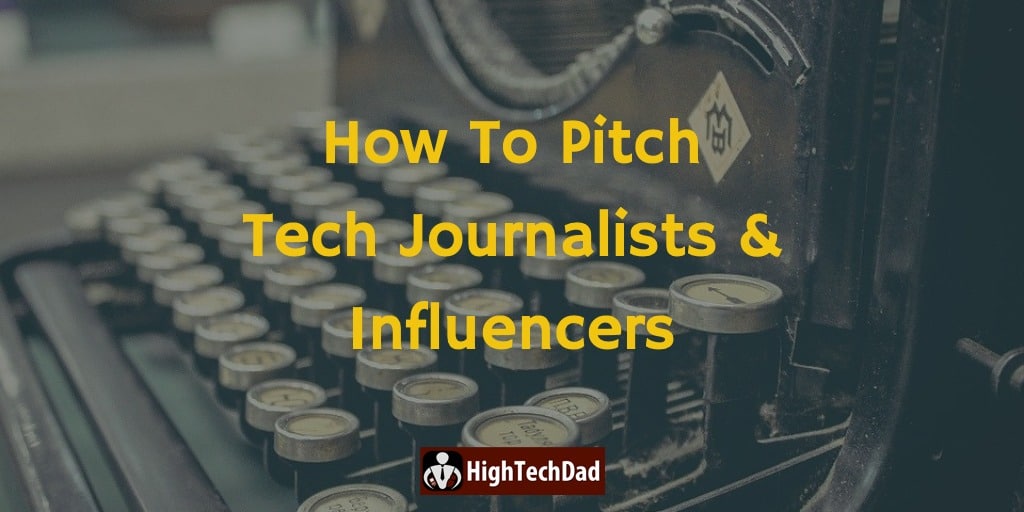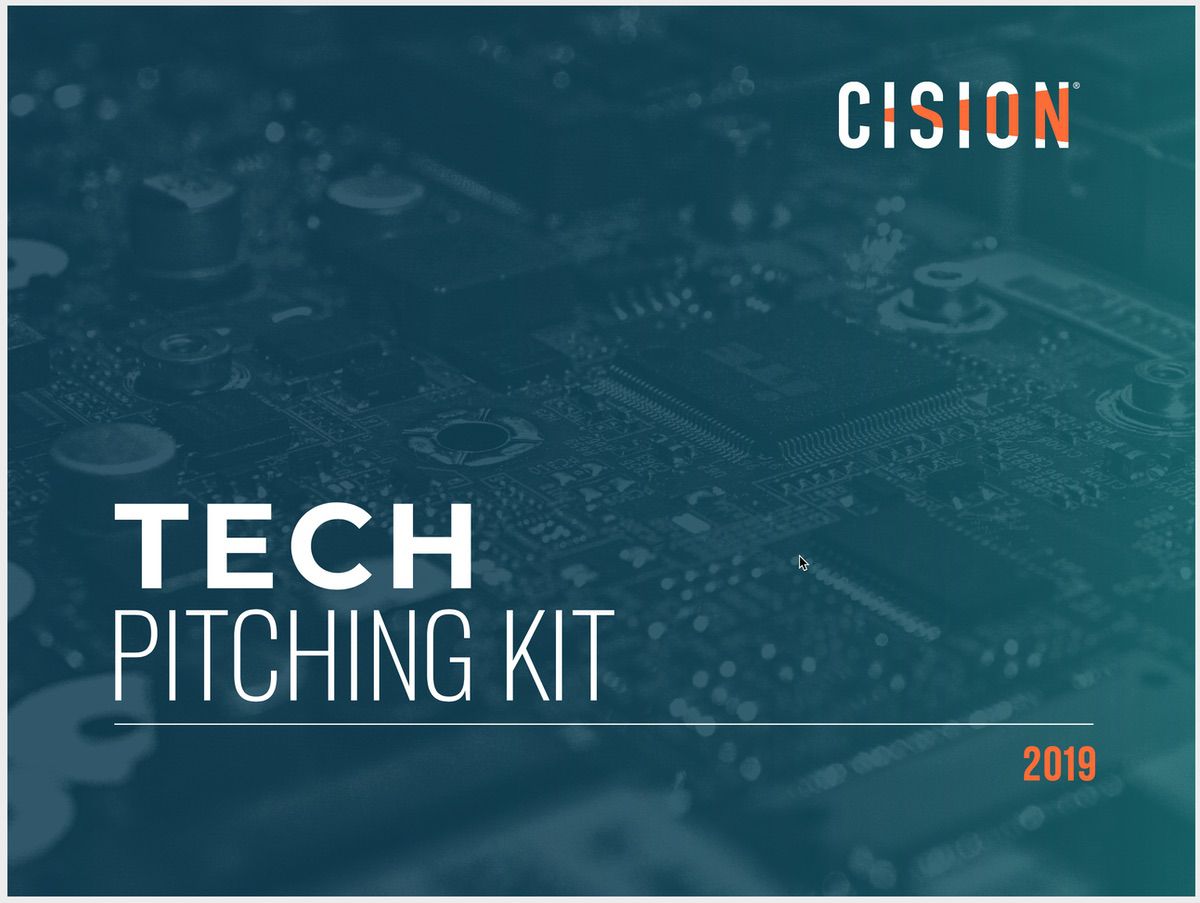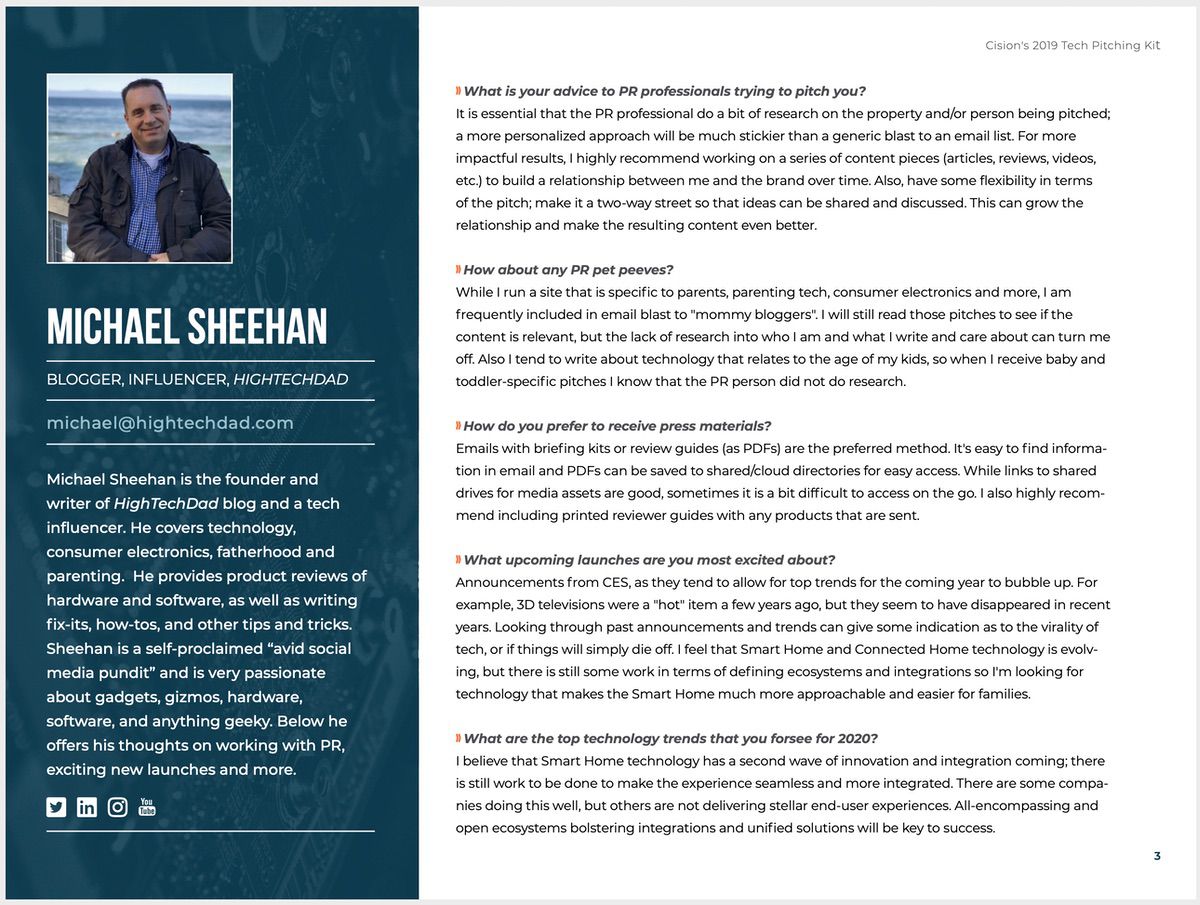Towards the end of 2019, I was asked by Cision, a company that “empowers communicators to identify influencers, craft and distribute meaningful stories, and measure the impact” to answer some questions related to the process of pitching technology journalists, bloggers, and influencers. I get pitches almost every day, some valid and some so utterly unrelated to my topics that I wonder if the company or PR firm pitching me has done any research whatsoever. With CES 2020 literally around the corner, I was happy to oblige in hopes that perhaps someone doing the media outreach from companies going to CES might actually read the advice. In the end, Cision produced a “Tech Pitching Guide,” which contained answers of eight tech writers (including me). While CES 2020 has long passed us by, I still wanted to share some of the answers, specifically mine.
This topic of how to connect and work with bloggers and tech media is near and dear to my heart. Back in 2012, I wrote an article “10 Ways Brands Can Work More Effectively with Top-Tier Bloggers,” where I outlined some best practices that I would want vendors, brands, or PR firms to follow when pitching me. I have worked both sides of the equation: as a content marketer pitching influencers within the tech industry (as part of my day job), and then as a tech writer, blogger, and influencer receiving pitches (my night and weekend “job”). I do feel it is essential to be able to understand both sides to be more effective, respectively.
I’m a Bit of a Grumpy Old Tech Writer
As I re-read my post from about eight years ago and compared my answers with the ones I provided to Cision (my full answers are at the end of this article), I realize that not much has changed over the years. And, in fact, I’m still a bit frustrated by the lack of quality and personalization of the pitches I receive today. I would estimate that about 5% of the outreach I receive now is relevant and of good quality, where it is clear that the vendor or agency has actually taken some time to understand my brand, what I’m passionate about, and what I cover.
Think of it this way. I tend to spend many hours writing an article. If it is product-related, I need to test the product thoroughly. As my articles are typically more than 1,000 words (frequently much longer), those take a lot of time to write and edit. I need to take quality photos and edit them. If a video is included, then there is filming and editing, which can take several hours as well. All in all, just one piece of content produced for my blog (or YouTube channel) can take anywhere from 3-10 hours.
In comparison, most of the pitches I get I’m guessing take about 30 seconds to copy and paste a generic pitch into an email.
Does that seem fair? I think not.
So, I have given up on responding to “can you edit this article and add our link” emails. Those are just lazy and those agencies are trying to simply piggyback on something that was already successful. No gain for me and the “compensation” I’m sometimes offered is not really worth my time.
In terms of guest posts, while I realize that guest posts help to build a site’s authority and can help with traffic. But ever since I launched HighTechDad.com over 15 years ago, I have never posted or allowed a guest post. Sorry to be selfish here but this is my site, my ideas, and my content…and I’m proud of it all.
Yet despite putting the “no guest posts” line on my auto-responders, in my about page, and on my contact forms, I still get emails asking to post “well-written articles” with the request of “do follow” links – again, those of you trying to pitch me that are simply trying to get my Page Rank and Authority juice.
Want me to write a sponsored article? Yes, I can do that but in my own words and obviously for a price.
Anyway, I digress. Let’s talk a bit about Cision and their Tech Pitching Guide.”
Cision’s Tech Pitching Guide
Frankly, I was honored to be asked by Cision to provide answers for their Tech Pitching Guide (free registration required). I viewed it as a great way to spread the gospel of what I would want. I realize that everyone has different priorities and thoughts on how they want to be pitched, so it is great to have other voices in this guide.
Below are the questions that were asked to and answered by eight tech writers:
- What is your advice to PR professionals trying to pitch you?
- How about any PR pet peeves?
- How do you prefer to receive press materials?
- What upcoming launches are you most excited about?
- What are the top technology trends that you forsee for 2020?
- What is the most challenging aspect of covering technology and the technology industry?
The first three questions are timeless and relevant to any agency or PR firm looking to pitch a story or product. The last three are more specific to the current state of technology, and since this guide came out towards the end of 2019 and right before CES 2020, fairly specific to that timing.
So, who did Cision ask for their perspective? I view the respondents as an interesting and rounded group of individuals (although I have to say, these are only male voices, so it would have been great to get some female perspectives as well). Below are the eight individuals interviewed (in order of appearance) and a brief bio on each.
Chip Carter
Freelance Writer CEO, Publisher And Editor-In-Chief, CBC3 Media Inc.
Chip Carter is a freelance writer and covers consumer electronics, computer and video games, technology and movies. He is also the founder of CBC3 Media Inc. and has recently moved into the broadcast television space. Carter has worked for the Chicago Tribune, still occasionally contributes to HuffPost, and offers some insights on how to pitch him, what kind of press releases he is looking for and more.

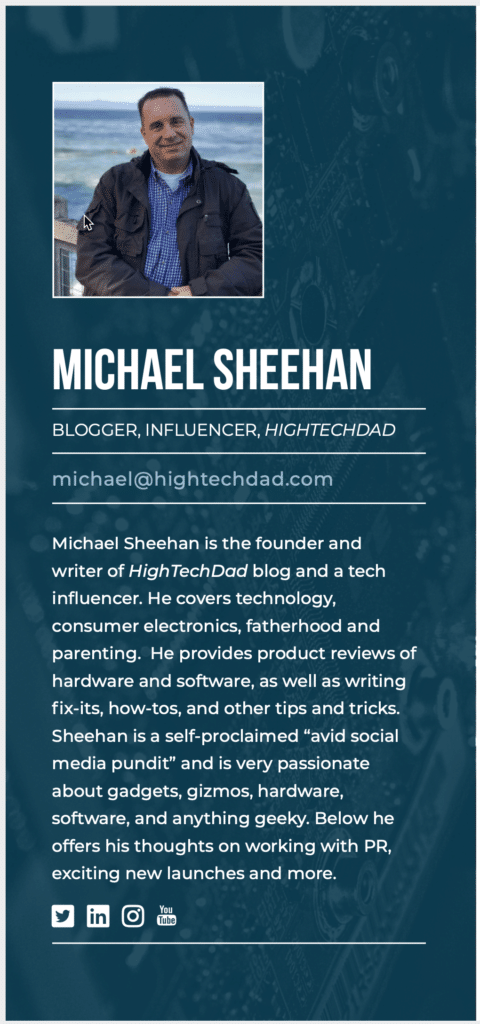
Michael Sheehan
Blogger, Influencer, HighTechDad
Michael Sheehan is the founder and writer of HighTechDad blog and a tech influencer. He covers technology, consumer electronics, fatherhood, and parenting. He provides product reviews of hardware and software, as well as writing fix-its, how-tos, and other tips and tricks. Sheehan is a self-proclaimed “avid social media pundit” and is very passionate about gadgets, gizmos, hardware, software, and anything geeky. Below he offers his thoughts on working with PR, exciting new launches and more.
Jeff Domansky
Managing Editor, PaymentsNEXT
Jeff Domansky is the managing editor of Payments NEXT, covering the online payment industry, cryptocurrency and blockchain technology industry, e-commerce and digital marketing. In the past, he created The PR Coach, an online PR resource with 8,500+ tips, insight and a blog for PR, social media professionals and business and have also contributed to many leading blogs such as ProBlogger, PR Daily, HR Communication, Blockcoin Today and many more online publications.
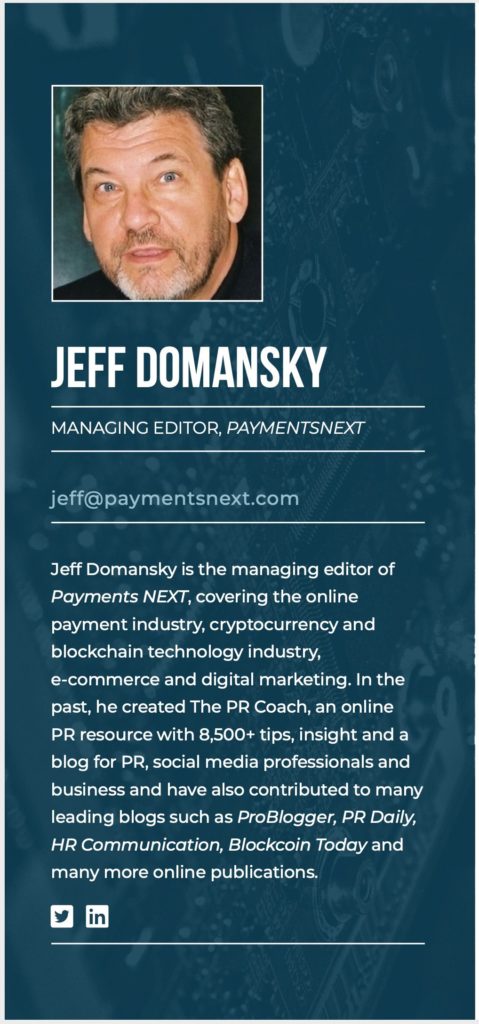

Andrew Orr
Associate Editor, Mac Observer
Andrew Orr is the associate editor at The Mac Observer and writes about Apple technology in the consumer market. He joined the staff in 2016 as a contributed and before that wrote for tech outlets such as LiquidVPN and Android Guys. Read his views on the tech industry, how to work with him, and more.
Tim Chan
Lifestyle & Market Editor, Rolling Stone
Tim Chan is the lifestyle and market editor for Rolling Stone and focuses on lifestyle, technology and consumer merchandise. He also contributes to Penske Media Corporation’s online properties at large and has been on staff since 2016. Find out how to pitch tech, what will catch his attention and what noteworthy tech trends he foresees in 2020.


Alfred Poor
Editor, Health Tech Insider
Alfred Poor is the founding editor of Health Tech Insider and covers medical technology. He often writes about how technology is disrupting traditional healthcare models for the better. Poor relies on data-driven analysis to show how employers can apply digital health technology to produce significant return on investment in employee fitness incentive programs. Read on for his views on working with PR, what catches his attention when it comes to pitches, and more.
Alex Hernandez
Publisher & Editor In Chief, Techaeris
Alex Hernandez is the founder, publisher and editor Techaeris, an online technology/lifestyle and reviews magazine that provides users the latest in technology news, reviews, geek entertainment, geek lifestyle, and more. He has a passion for consumer technology and gadgets for and in the last five years has grown the website from a relative unknown into a respected source for tech news and product reviews. Below is his advice on how to pitch him, what will catch his attention, and more.


Richard Bartram
Editor-In-Chief, La Tech News Nashville Tech NewsNyc Tech News
Richard Bartram is the editor-in-chief and publisher for LA Tech News, Nashville Tech News, NYC Tech News and International Tech News. He covers technology and tech industry news, including education technology, wellness technology, financial technology, science, startups, venture capital, tech events and product reviews. Read his thoughts on the tech industry, advice to PR professionals trying to pitch him, and more.
I have read through all of the answers from the writers above and there is a clear and common thread – be “relevant” and “personal.” Pretty much the same thing I have been saying again…and again…and again.
HighTechDad’s Answers to for the Tech Pitching Guide
As the Tech Pitching Guide is something that Cision produced and published, I can’t provide the answers to what others in the guide provided. You will need to register on the Cision site to download the guide.
However, since I was the one to provide my own answers (and Cision edited down my lengthy responses – I tend to write a lot), I wanted to offer my complete answers.
What is your advice to PR professionals trying to pitch you?
When being pitched, I feel it is essential that the PR professional do a bit of research on the property and/or person being pitched. While it can take a bit longer to do properly, a more personalized approach will be much stickier than a generic blast to an email list. I also am a firm believer in continuity when it comes to pitching. I understand that brands and PR may be looking for one-hit content, meaning I am pitched – I write the content – and the brand/PR person moves on never to be in contact again. For more impactful results, I highly recommend working on a series of content pieces (articles, reviews, videos, etc.) to build a relationship between me and the brand over time. This continuity is reflected in the later produced content. Also, have some flexibility in terms of the pitch. Make it a two-way street so that ideas can be shared and discussed. This, as well, can grow the relationship and make the resulting content even better.
How about any PR pet peeves?
While I run a site that is specific to parents, parenting tech, consumer electronics and more, I am frequently included in email blasts to “mommy bloggers” with the content of those emails being gear more towards females than males. I will still read those pitches to see if the content is relevant to me and my audience, but the lack of research into who I am and what I write and care about can turn me off. Also, and while this is more specific to my site, I tend to write about technology that relates to the age of my kids as I often use their opinions about a device as content for my reviews and articles. So when I receive baby and toddler-specific pitches, I know that the PR person did not do research.
How do you prefer to receive press materials?
For me, getting emails with briefing kits or review guides (as PDFs) is the preferred method. It’s easy to find information in email and PDFs can be saved to shared/cloud directories for easy access. While links to shared drives for media assets is good, sometimes it is a bit difficult to access when you are on the go. However, it is always good to have those types of documents available online at any time when it comes to content creation. I also highly recommend including printed out reviewer guides with any products that are sent. Including these documents in the box makes the process much easier.
What upcoming launches are your most excited about?
I’m always interested in announcements coming from CES as they tend to allow for top trends for the coming year to bubble up. While the barrage of media materials can be a bit overwhelming, one can pick through the announcements to identify what technologies are hot and what are not. For example, 3D televisions were a “hot” item a few years ago, but they seem to have disappeared in recent years. Looking through past announcements and trends can give some indication as to the virality of tech, or if things will simply die off. I feel that Smart Home and Connected Home technology is evolving, but there is still some work in terms of defining ecosystems and integrations so for me, I’m looking for technology that make the Smart Home much more approachable and easy for families.
What are some technology trends that you foresee for 2020?
I believe that Smart Home technology has a second wave of innovation and integration coming. We have many connected devices, but I believe there is still work to be done to make the experience seamless and more integrated. There are some companies doing this pretty well, but others are trying but not delivering stellar end-user experiences. All encompassing and open ecosystems bolstering integrations and unified solutions will be key to success.
What is the most challenging aspect of covering technology and the technology industry?
There is a lot of technology available. In order to remain focused, I felt the need to choose a niche – that of family tech. Understanding which devices or technology is relevant or not for the household allows for a fine-tuning of focus. And, in order to keep this focus, I try to choose items that are relevant to the point in life my family is at. So cribs or nanny cams for me isn’t relevant, but smart beds (for adults to help their “old aching backs”) or integrated security cameras is relevant. Also, often doing a reverse pitch, where I contact a particular brand without having a named contact or connection can be a bit maddening as email are often simply not responded to. I may get a recommendation on a product from family, friends or my readers/audience, reach out to the brand, and never hear back. This can be frustrating.
Boiling It All Down
So yeah, a lot to read here. But if I were to boil it down for you, here’s what I would say:
- Do some research – learn about who you are pitching and what excites them
- Make it personal – don’t just link to the latest article or say I have been following FILL IN SITE HERE, prove it
- Be relevant – again, this ties to the previous two points
- Make it valuable for me – I put a lot of hard work into my content and site, please do the same
- Develop a relationship – after I do your article, don’t just disappear
The bottom line here is Quality In = Quality Out. If you don’t put some quality time into doing your research and delivering a relevant pitch that is worth my time to read, investigate, and potentially act on, it’s really, really easy for me to just hit that DELETE button.
That being said, if you want to get in touch, please head over to my Contact section and drop me a note, or leave a comment, or connect with me on social media.
HTD says: I would absolutely LOVE to review your technology product! But please follow some of these tips to ensure that what you are pitching me is relevant and worth me investing time in you and your product.
